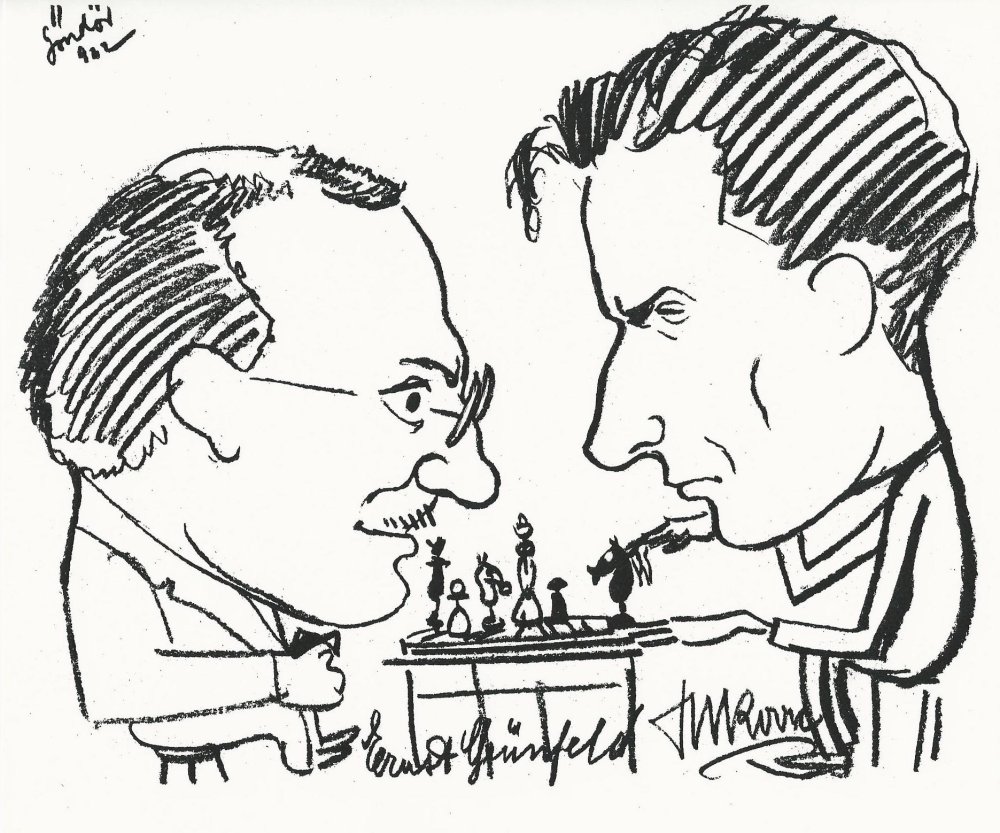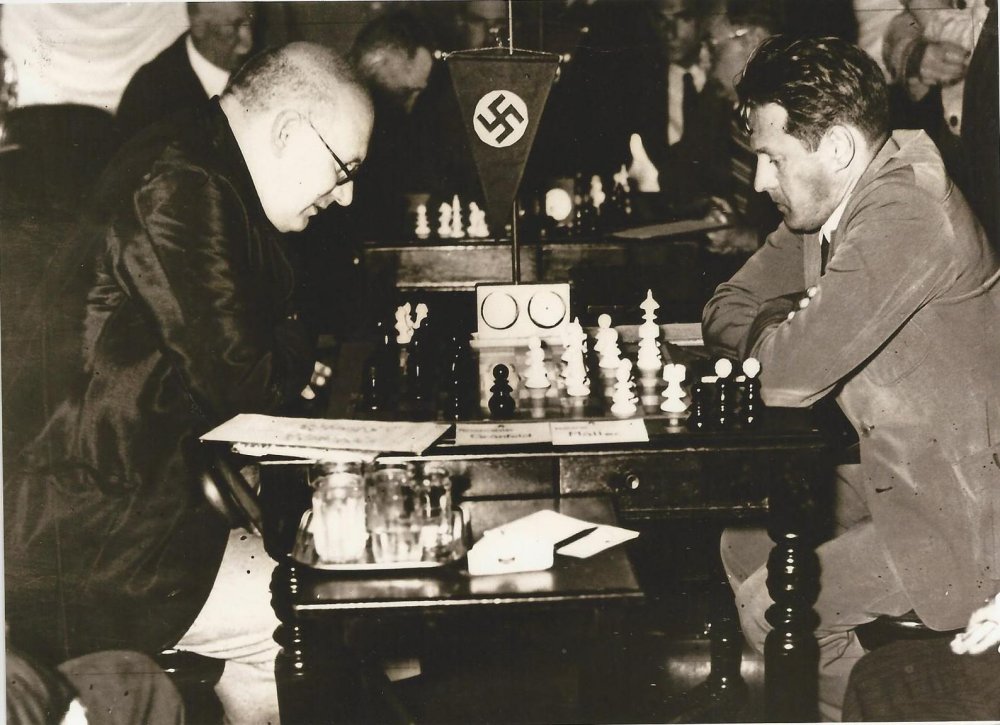


"Homo Neubau" is an exhibition about the years 1938 to 1945 and how people from the seventh district of Vienna, i.e. from Neubau, fared during this time. No one is represented in this exhibition in nearly as much detail as Ernst Grünfeld (1893-1962), who lived almost his entire life in Neubau, whose building fabric, despite its name (the literal translation of "Neubau" is "New Build"), dates mainly from the 19th century. Fifteen text panels, dozens of photos, a film sequence and a display case full of books tell about the life of a chess master and Nazi collaborator.
Putting Grünfeld at the centre of the exhibition was not planned. It turned out that way. The Vienna New District Museum in the Amerlinghaus, an over three hundred years old two-storey building with a charming inner courtyard, has become one of the focal points of Viennese chess in the last two years.
Several clubs meet here. In a city competition in hybrid chess, Vienna competed against Berlin from the museum. When the museum director Monika Grußmann talked about the planned exhibition, the name Ehn quickly came up. Michael Ehn knows Austrian chess history like no other. Curator Sonya Todorova drew on his knowledge and his collection. Last Thursday a tournament with ten-minute games took place in the exhibition rooms. Similar tournaments might follow. In autumn, Ehn will give a lecture on Grünfeld.
More about the exhibition and Grünfeld (in German)...
Trivia chess quiz: Which 20th century player became one of the top players of his time though he was already 18 years old when he learned the rules of the game?
Ernst Grünfeld became interested in the game while one half of the 1910 World Championship match Lasker - Schlechter was played in his home town of Vienna. He was taught the game a year later by his brother-in-law, Oskar Zimmermann, an activist in the workers' chess movement. As a child Grünfeld had lost a leg in an accident and had to wear prostheses all his life. A sport that he could practise while sitting came in handy.

Emmerich Göndör drew Grünfeld (left) and Vladimir Vukovic (right) in 1922 at the Vienna tournament, during which Grünfeld managed to beat no other than the later World Champion Alexander Alekhine with the Grünfeld Defense.
During World War I he was spared from front-line service, but he lost his father and two brothers in the war. Because of his disability Grünfeld could not take over the bronze foundry, where he had done the bookkeeping. Lacking alternatives, Grünfeld became a chess professional when the family gave up the workshop.

Ernst Grünfeld, Moscow 1925
His best years began when he won the German Championship in 1923, in which he could start as a representative of Austria – at that time, many believed that Austria would not stay independent for a long time.
In 1923 Grünfeld was one of the ten strongest players in the world. In Margate he won ahead of Alekhine, Bogolyubov and Réti, and a year later, in Merano, he won ahead of Spielmann and Rubinstein. In 1925 he finished ninth in the Moscow tournament. In the silent film Chess Fever, which was made during the Moscow tournament, Grünfeld is repeatedly in the picture.
Ernst Grünfeld can be seen between 1'39'' and 1'59'', together with Rudolf Spielmann on the left.
His strengths were his excellent memory and his carefully kept opening analyses, the often quoted "opening box". Since the winter of 1921/22, this box contained a revolutionary new opening (1.d4 Nf6 2. c4 g6 3. Nc3 d5). Its inventor repeatedly thought that his opening was refuted (for instance by 4. e3 or by 4. Nf3 Bg7 5. Qb3), but the Grünfeld is still alive and many books have been written about it. In the exhibition these books fill a display case, and today, half the world's elite plays the Grünfeld and ensures that his name is not forgotten.
Because of his name he was often mistaken for a Jew and attacked by anti-Semites in Viennese chess circles. When Austria was absorbed into the Nazi Reich in 1938, Grünfeld joined the NSDAP, probably less out of conviction than to protect himself, Michael Ehn suspects.
From Ehn's archives come photos showing Grünfeld with party insignia, as well as the "Anschluss" issue of the Deutsche Schachblätter from April 1938, in which he introduced himself to readers in the following way: "Contrary to all suspicions of the past, I am therefore in the fortunate position of being able to prove my Aryan ancestry even to a much envied and rare level."

Grünfeld, left, against Hans Müller, Christmas Tournament Vienna 1938
Grünfeld was employed pro forma by the tax office and paid for simultaneous games, publications and chess lessons with the sports organisation Kraft durch Freude or with the Wehrmacht.

Ernst Grünfeld, 1960, at a simul
After the war, of course, that was over. He was hardly in demand as a chess teacher and author. The only thing that saved him from complete impoverishment was his flat at Schottenfeldgasse 86, a quarter of an hour's walk from the Neubau District Museum.
Since his childhood Ernst Grünfeld had lived in the Schottenfeldgasse 86, and here the first analyses of the Grünfeld Defense were made.
On the ground floor, where the Grünfeld bronze goods shop probably used to be, there is now an Asian restaurant. There is spice in its name, just like in the opening, which was concocted in the house a hundred years ago.
The Grünfelds family grave
A letter by Ernst Grünfeld which was published as a preface in the book "Grünfeldova Indiska odbrana", Trifunovic, P., B. Gruber, A. Bozic, Beograd 1951, was translated especially for the exhibition.
THE GRÜNFELD DEFENSE
A Letter from Grandmaster Ernst Grünfeld. A Contribution to the History of the Grünfeld-Indian Defense
I was very pleased when I heard that in Yugoslavia of all places, the country where chess is so popular and present, a detailed work on the opening bearing my name was being published. I gladly accepted the kind invitation to make a small contribution to the subject of this important work. The idea of a new defence against the Queen's Pawn Opening (1.d4) arose as early as 1921. The defensive strategies against the Queen's Gambit available to Black at that time were not satisfactory. ...
The entire letter as pdf (German)...
Translation from German: Johannes Fischer